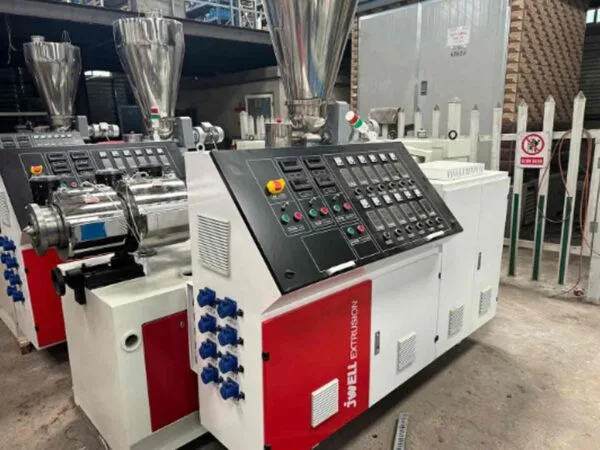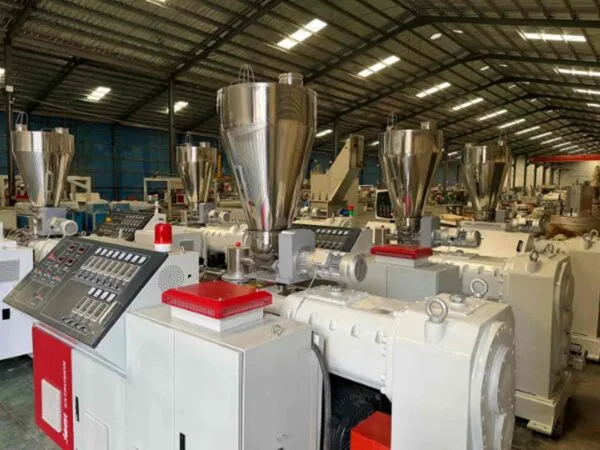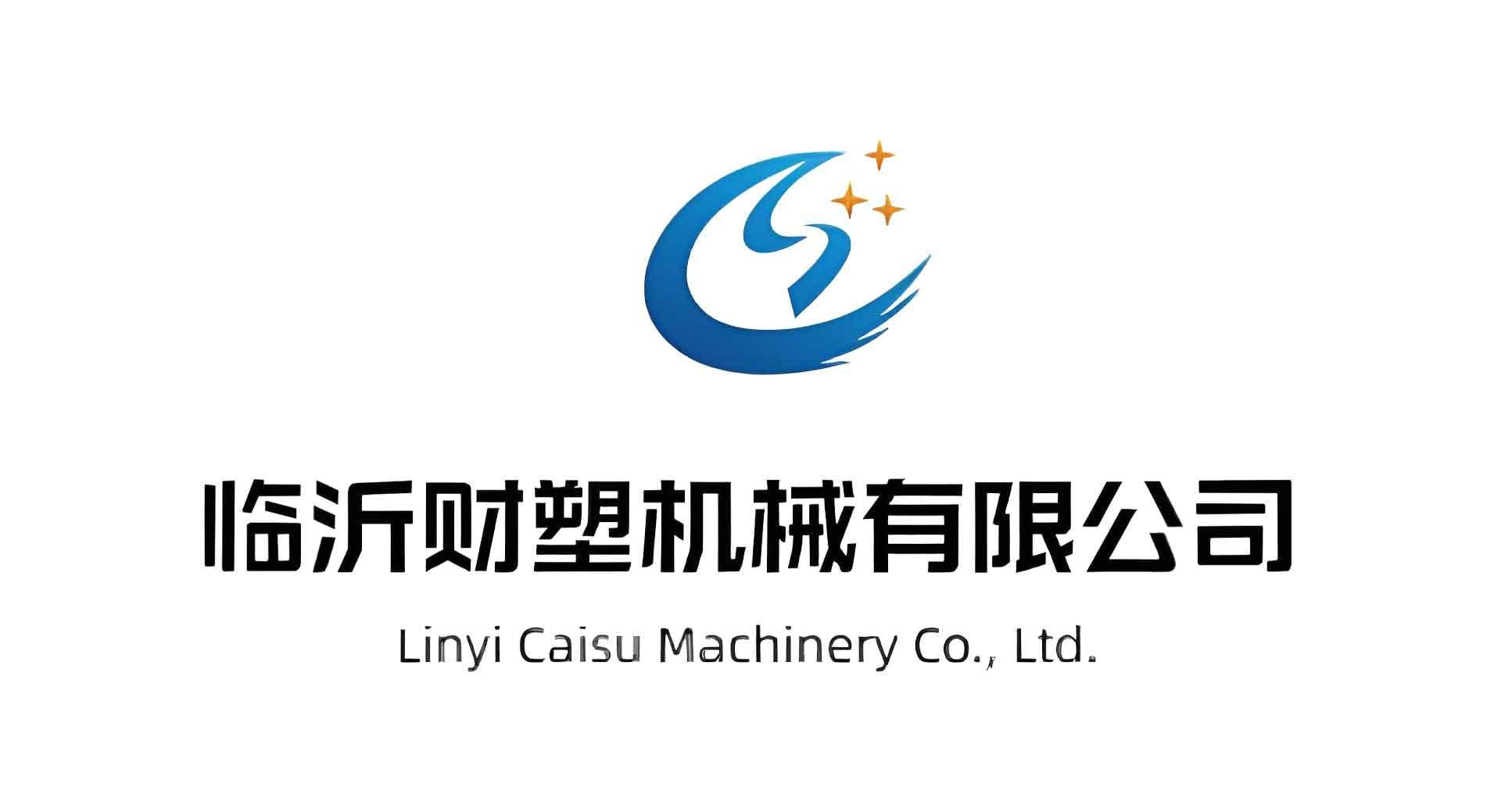Welcome to My Blog!
Before we dive into the content, I’d love for you to join me on my social media platforms where I share more insights, engage with the community, and post updates. Here’s how you can connect with me:
Facebook:https://www.facebook.com/profile.php?id=61567891941530
Now, let’s get started on our journey together. I hope you find the content here insightful, engaging, and valuable.
Caisu Machinery sells a variety of used plastic pipe production equipment. The products are of high quality and low price. Welcome to contact us for consultation and purchase. We will be happy to serve you.
Table of Contents
Introduction

The application of twin screw extruder in the plastic industry is pivotal for producing high-quality polymers, compounds, and recycled materials, particularly in Europe, where the plastics sector contributes €350 billion annually, as per Plastics Europe. These versatile machines, featuring two intermeshing screws, excel in compounding, pelletizing, and recycling, meeting the region’s demand for sustainable, high-performance plastics in automotive, packaging, and construction. With EU regulations pushing for 65% plastic recycling by 2035, the application of twin screw extruder is critical for innovation and compliance.
This comprehensive guide explores its processes, materials, and sustainability benefits, offering a comparison table and FAQ to assist European manufacturers in optimizing production while adhering to stringent environmental standards.
Understanding the Application of Twin Screw Extruder
The application of twin screw extruder in the plastic industry encompasses a range of processes that transform raw polymers into tailored products, from automotive components to biodegradable films. Known for superior mixing and high throughput, these machines are integral to Europe’s advanced manufacturing landscape. This section examines their design, advantages, and core applications, supported by insights from industry sources like Torontech and Plastics Technology, tailored to European plastic processing needs.
Design and Mechanics in the Application of Twin Screw Extruder
The application of twin screw extruder relies on a design featuring two parallel screws—co-rotating or counter-rotating—within a heated barrel, as per Torontech. Co-rotating screws, rotating in the same direction, dominate in plastics for their high shear and mixing efficiency, processing up to 10 tonnes/hour, as noted by industry data. Counter-rotating screws, used for high-viscosity materials, offer high pressure for profiles like PVC pipes, as per Plastics Technology. Modular screws and barrels, with L/D ratios of 32:1 to 48:1, allow customization for specific polymers, ensuring the application of twin screw extruder meets diverse European production demands, from compounding to direct extrusion.
Advantages Driving the Application of Twin Screw Extruder
The application of twin screw extruder offers distinct advantages over single screw extruders. Superior mixing, driven by intermeshing screws, ensures uniform dispersion of additives, achieving 95–98% homogeneity, as per Torontech. High throughput, up to 50% greater than single screw models, boosts efficiency for large-scale European plants, as noted by Plastics Technology. Starve-fed operation allows precise control, reducing material waste by 10–15%, as per industry standards. Energy-efficient motors, with 90% efficiency, align with EU’s sustainability goals, making the application of twin screw extruder ideal for eco-conscious manufacturers in Germany or Sweden.
Core Processes in the Application of Twin Screw Extruder
The application of twin screw extruder spans multiple processes: compounding, pelletizing, recycling, and direct extrusion. Compounding blends polymers with additives, like flame retardants, for automotive parts, as per Plastics Technology. Pelletizing produces uniform granules for injection molding, critical for packaging in Italy, as noted by industry data. Recycling transforms post-consumer plastics into high-quality pellets, supporting EU’s Circular Economy Action Plan, as per Torontech. Direct extrusion creates profiles like pipes without intermediate pelletizing, saving 20% energy, as per industry insights. These processes highlight the versatility of the application of twin screw extruder in European plastics manufacturing.
Materials Processed in the Application of Twin Screw Extruder
The application of twin screw extruder handles a wide range of plastics, including thermoplastics (PP, PE, PET), engineering plastics (PA6, PC), and biodegradable polymers (PLA). Polyolefins, comprising 50% of Europe’s plastic production, are compounded for films, as per Plastics Europe. Engineering plastics, used in automotive, benefit from high-torque extruders for glass fiber reinforcement, as noted by Torontech. Biodegradable plastics, growing 15% annually, are processed for sustainable packaging, aligning with EU regulations, as per industry data. This material versatility underpins the application of twin screw extruder across European industries.
European Context for the Application of Twin Screw Extruder
In Europe, the application of twin screw extruder is shaped by robust industrial demand and regulatory frameworks. The region’s 60,000 plastic companies, employing 1.5 million, rely on extruders for innovation, as per Plastics Europe. Germany’s automotive sector uses compounded plastics for lightweight parts, reducing emissions by 10%, as noted by industry sources. Italy’s packaging industry, producing 14 million tonnes annually, leverages pelletizing for quality, as per Torontech. EU directives, like the Single-Use Plastics Directive, drive recycling applications, ensuring the application of twin screw extruder aligns with sustainability and compliance in European markets.
Key Processes in the Application of Twin Screw Extruder

The application of twin screw extruder involves specialized processes that enhance plastic quality and sustainability. This section explores compounding, recycling, pelletizing, and direct extrusion, providing technical insights for European manufacturers to optimize production, supported by industry data.
Compounding in the Application of Twin Screw Extruder
Compounding, a primary application of twin screw extruder, blends polymers with additives like fillers, colorants, or flame retardants to tailor properties. For example, adding 30% glass fiber to PA6 increases tensile strength by 50%, ideal for automotive parts, as per Plastics Technology. Co-rotating extruders, with high shear, ensure uniform dispersion, achieving 98% additive integration, as noted by Torontech. This process supports Europe’s demand for high-performance plastics in construction and electronics, ensuring the application of twin screw extruder meets stringent quality standards under EU regulations like REACH.
Recycling in the Application of Twin Screw Extruder
Recycling, a growing application of twin screw extruder, processes post-consumer and post-industrial plastics into high-quality pellets. PET bottle recycling, handling 2.1 million tonnes annually in Europe, achieves 90% purity with twin screw extruders, as per Plastics Europe. Devolatilization removes contaminants, improving granule quality by 15%, as noted by Plastics Technology. This aligns with EU’s 2035 recycling target, making the application of twin screw extruder critical for circular economy initiatives in countries like the Netherlands, where recycling rates exceed 50%, as per industry data.
Pelletizing in the Application of Twin Screw Extruder
Pelletizing, another key application of twin screw extruder, produces uniform granules for downstream processes like injection molding. Granules, sized 2–4 mm, ensure consistent flow, reducing defects by 20% in packaging production, as per Torontech. Water strand or underwater cutting systems maintain dimensional stability, critical for Italy’s film industry, as noted by industry standards. The application of twin screw extruder in pelletizing supports high-throughput plants, processing up to 1000 kg/hour, enhancing efficiency for European manufacturers adhering to quality standards like ISO 9001.
Direct Extrusion in the Application of Twin Screw Extruder
Direct extrusion, an energy-efficient application of twin screw extruder, produces profiles like pipes or films without pelletizing, saving 15–20% energy, as per Plastics Technology. PVC pipes, used in European construction, benefit from counter-rotating extruders for high-pressure output, as noted by Torontech. This process reduces processing steps, cutting production time by 10%, as per industry data. The application of twin screw extruder in direct extrusion suits Germany’s infrastructure projects, ensuring compliance with EN 1329 standards for drainage systems.
Sustainability in the Application of Twin Screw Extruder
Sustainability drives the application of twin screw extruder, particularly in recycling and biodegradable plastics. Extruders process PLA for compostable packaging, growing 20% annually, as per Plastics Europe. Energy-efficient designs, with 90% motor efficiency, reduce CO2 emissions by 15%, as noted by Torontech. Recycling applications cut virgin plastic use by 30%, supporting EU’s Circular Economy Action Plan, as per industry standards. This focus ensures the application of twin screw extruder aligns with Europe’s environmental goals, benefiting manufacturers in Sweden and Denmark prioritizing green production.
Comparison Table and Insights on the Application of Twin Screw Extruder
To illustrate the application of twin screw extruder, the following table compares key processes, their features, and applications in the European plastic industry.
| Process | Key Features | Applications |
|---|---|---|
| Compounding | High shear, 95–98% additive dispersion, co-rotating screws | Automotive parts, electronics |
| Recycling | Devolatilization, 90% purity, starve-fed operation | PET bottles, post-consumer plastics |
| Pelletizing | Uniform 2–4 mm granules, water strand cutting | Packaging films, injection molding |
| Direct Extrusion | 15–20% energy savings, counter-rotating screws | PVC pipes, construction profiles |
Insights on the Application of Twin Screw Extruder
The table highlights the versatility of the application of twin screw extruder. Compounding ensures high-performance plastics for automotive, achieving 50% strength gains, as per Plastics Technology. Recycling supports EU’s 65% target, processing 2.1 million tonnes of PET, as noted by Plastics Europe. Pelletizing enhances packaging quality, reducing defects by 20%, as per Torontech. Direct extrusion optimizes construction, saving energy, as per industry data. Selecting the right process depends on material, output, and regulatory needs, ensuring the application of twin screw extruder drives efficiency and sustainability in European plastics manufacturing.
Strategies for Optimizing the Application of Twin Screw Extruder
To maximize the application of twin screw extruder, match screw configuration to material properties. Use co-rotating screws for compounding PP with additives, as per Torontech. Employ counter-rotating screws for PVC direct extrusion, ensuring high pressure, as noted by Plastics Technology. Implement loss-in-weight feeders for 99% feed accuracy in recycling, as per industry standards. Regular maintenance, cleaning screws every 500 hours, extends lifespan by 20%, as per technical data. These strategies enhance the application of twin screw extruder, ensuring compliance with EU standards like ISO 14001 for environmental management.
Practical Considerations for the Application of Twin Screw Extruder


Effective implementation of the application of twin screw extruder requires strategic planning, maintenance, and operator training. This section provides actionable guidance for European manufacturers to optimize performance and compliance.
Material Selection for the Application of Twin Screw Extruder
Choosing the right polymer is critical for the application of twin screw extruder. PP and PE, used in 50% of European plastics, suit compounding for films, as per Plastics Europe. PET, with 2.1 million tonnes recycled annually, is ideal for recycling applications, as noted by Torontech. PLA requires precise temperature control (180–220°C) for biodegradable packaging, as per industry data. Verify material viscosity and additive compatibility, ensuring the application of twin screw extruder achieves 95% homogeneity, supporting quality standards in Germany’s automotive or Italy’s packaging sectors.
Maintenance in the Application of Twin Screw Extruder
Maintenance ensures reliability in the application of twin screw extruder. Clean screws and barrels every 500 hours to prevent residue buildup, reducing downtime by 15%, as per Torontech. Inspect gearboxes annually, maintaining oil levels for 90% efficiency, as noted by Plastics Technology. Calibrate temperature controls (200–300°C) weekly to avoid polymer degradation, as per industry standards. A maintenance schedule extends equipment life by 20%, ensuring the application of twin screw extruder supports high-throughput European plants adhering to ISO 9001 quality protocols.
Operator Training for the Application of Twin Screw Extruder
Operator training enhances the application of twin screw extruder. Train staff for 8–12 hours on screw configuration, feeder settings, and safety, reducing errors by 80%, as per EU safety guidelines. Ensure familiarity with PLC controls for 99% process accuracy, as noted by Torontech. Regular drills on emergency stops and maintenance protocols, mandatory under EN ISO 12100, improve safety, as per industry data. Trained operators optimize the application of twin screw extruder, ensuring consistent quality in Sweden’s recycling or France’s compounding facilities.
Regulatory Compliance in the Application of Twin Screw Extruder
Compliance with EU regulations is essential for the application of twin screw extruder. Adhere to REACH for safe additive use, ensuring 100% chemical compliance, as per Plastics Europe. Meet the Circular Economy Action Plan, targeting 65% recycling by 2035, through recycling applications, as noted by Torontech. Use energy-efficient motors to comply with EU Ecodesign Directive, reducing emissions by 15%, as per industry standards. Verifying compliance ensures the application of twin screw extruder avoids penalties and supports sustainable production in European markets.
Challenges in the Application of Twin Screw Extruder
Challenges in the application of twin screw extruder include material contamination, energy costs, and process complexity. Contaminated feedstocks reduce pellet quality by 10%, mitigated by devolatilization, as per Plastics Technology. High energy use, up to 0.5 kWh/kg, raises costs, addressed by efficient motors, as noted by Torontech. Complex screw configurations require skilled operators, as per industry data. Address these by testing materials, optimizing energy settings, and investing in training, ensuring the application of twin screw extruder meets European quality and sustainability standards.
Conclusion
The application of twin screw extruder revolutionizes the European plastic industry, enabling high-quality compounding, recycling, and extrusion while supporting sustainability goals. By leveraging advanced processes, optimizing materials, and ensuring compliance, manufacturers enhance efficiency and environmental impact.
This guide, with its table and FAQ, equips professionals to harness the application of twin screw extruder for innovative, compliant production. Explore the FAQ for deeper insights to streamline your processes.
FAQ
What is the application of twin screw extruder in plastics?
It includes compounding, recycling, pelletizing, and direct extrusion for automotive, packaging, and construction.
Why use co-rotating screws in the application of twin screw extruder?
Co-rotating screws offer 95–98% mixing efficiency, ideal for compounding and recycling, as per industry data.
What materials suit the application of twin screw extruder?
PP, PE, PET, and PLA, used in films, automotive parts, and biodegradable packaging.
How does recycling work in the application of twin screw extruder?
It processes post-consumer plastics into 90% pure pellets, supporting EU’s 65% recycling target.
What are the benefits of the application of twin screw extruder?
High throughput, 15–20% energy savings, and compliance with EU sustainability standards.





